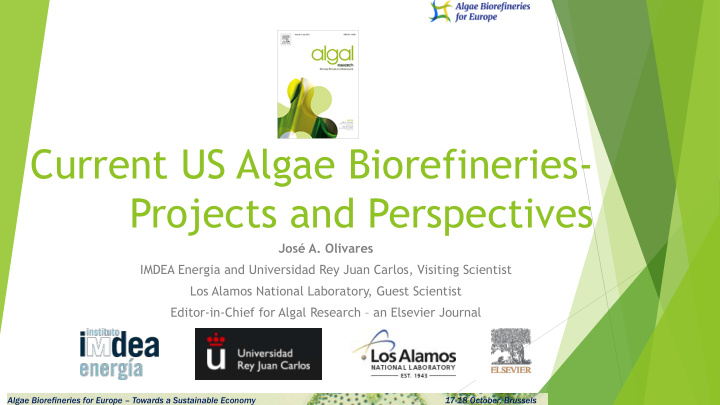



Current US Algae Biorefineries- Projects and Perspectives José A. Olivares IMDEA Energia and Universidad Rey Juan Carlos, Visiting Scientist Los Alamos National Laboratory, Guest Scientist Editor-in-Chief for Algal Research – an Elsevier Journal Algae Biorefineries for Europe – Towards a Sustainable Economy 17-18 October, Brussels
Headliner Productivity Photo Source: AP News Eye Press • Qingdao, China • Green alga ( Ulva prolifera ) • late May - early July 2008 • > 200,000 tons biomass • < 17 km 2 coastal area (~ 4,200 acres) Ø 47 tons/acre Ø 118 tons/ha Photo Source: NBC Olympics Website Vs. Land Plant Productivity of 10-30 Tons/ha/yr.
The Algal Biorefinery Lipid co- products, Omega- 3 Fatty Acids (FAME) (alkanes) Methane, Renewable Diesel, SPK liquefaction Alcohols, methane Slide 3
Integrated Biorefinery (IBR) Program Key Challenges Involve Lowering the Risks § Inadequate Supply Chain Infrastructure § Processing, Conversion and Production Costs § Replicability § Scalability (sustainability) § Financing § Offtake Agreements § Biofuels Distribution Infrastructure § Codes, Standards, and Approval for Use § Consumer Lack of Acceptance and Awareness
US Department of Energy – BioEnergy Technologies Office (BETO) Demonstration and Market Transformation (DMT) Integrated Biorefinery (IBRs)
Algenol Goals of the Algenol Integrated Biorefinery prove the commercial viability of the bioconversion of • industrial waste CO2 into liquid transportation fuels in enclosed photobioreactor systems proprietary metabolically enhanced algae • • evaluate enclosed photobioreactor systems and metabolically enhanced algae bioenergy production and Carbon Capture and Utilization • • various climates Scale § § Up to 2 tonnes CO2/Day DOE Funds (2010-2015) - $25 M § § Up to 18,000 gal/yr EtOH Cost Share - $25 M § § Up to 3,000 gal/yr greencrude Partners: • PNNL – Hydrothermal Liquefaction DOE – Donated used Hydrothermal Liquefaction unit to Algenol • for IBR • Leading plastics manufacturers Plastics welding equipment manufacturers •
Algenol Construction of commercial scale 2 acre PBR system § 6120 PBRs § Full integration of all processes § Ethanol dehydration § Greencrude production § Operated 4000 photobioreactor system for over 500 days § Next generation PBR production system developed § Lower cost system is 3x larger than prior generation reactors § Significant improvements in manufacturing quality, brought in § house all photobioreactor manufacturing Increased genetic stability of commercial production strain § Commercial production strain converts extraordinary amount § of carbon into fuel 80% carbon branching into ethanol § Successful creation of antibiotic resistance-free ethanologenic § AB1 strains
BioProcess Algae (Iowa) DOE Funds (2013-2017) - $6 M Cost Share - $6 M Partners: BioProcess Algae, Sweetwater Energy and Elevance Renewable Science
Sapphire Energy DOE Funds (2010-2014) - $36 M Cost Share - $52 M Partners ü Harris Group ü Brown and Caldwell ü AMEC/Geomatrix ü Linde (CO2 and conversion) ü Tesoro (offtake agreement) ü Phillips 66 (upgrading and part 79 registration for on road diesel fuel) ü DOE co-processing grant
Sapphire Energy
Solazyme DOE Funds (2010-2012) - $22 M Cost Share – $8.7 M Partners ü Abengoa Bioenergy Corp. ü BlueFire Ethanol, Inc. ü Renewable Energy Group, Inc. ü UOP LLC
Solazyme
2016 Multiyear Project Plan, BioEnergy Technologies Office
CHALLENGES TO TARGET • Biology and culture management for productivity • Low-cost, scalable cultivation systems • Low-cost, high-throughput harvest technologies • Performing integrative analysis to identify critical barriers Developing higher-value co- products • Demonstrating feasible routes to finished fuels 2016 Multiyear Project Plan, BioEnergy Technologies Office
$14 M $14 M $20 M $18 M $15 M $8.8 M
New Algae Integrated Biorefinery (IBR) Project Announced Kauai Algae Facility Integrated inoculation through harvesting • • CO 2 from adjacent power plant flue gas Demonstrated contamination control • Demonstrated Zobi Harvester TM • Full cultivation media recycle • ABY1 strain improvement tools • Alga Biomass Yield Phase 2 Lipid oil pathway yield 2200-3700 gal/ac-yr • HTL oil pathway yield 4200-6500 gal/ac-yr • Pre-processing energy (% of biofuel): 10-5% • Demonstration in integrated outdoor system • Integrated Biorefinery Project $1.2 M project • Pilot-scale algae biofuel facility • Improved productivity of open pond cultivation • More energy-efficient algae harvest •
11 – 13 June 2018 Motiff Seattle Hotel, Seattle, WA, USA www.algalbbb.com Algae Biorefineries for Europe – Towards a Sustainable Economy 17-18 October, Brussels
Algal Research Algal Research is an international phycology Editor-in-Chief: Jose Olivares (USA) journal covering all areas of emerging technologies Associate Editor: Eric Dunlop (Australia) in algal biology , biomass production, cultivation, harvesting, extraction, bioproducts, and Associate Editor: Ivet Ferrer (Spain) econometrics. It publishes original research and Associate Editor: Peter Lammers (USA) reviews on algal biology (phylogeny, molecular traits and metabolic regulation of microalgae for Associate Editor: Marie Magnusson (Australia) biofuels), algal cultivation (phototrophic systems Associate Editor: Jason Quinn (USA) in open ponds, heterotrophic systems), algal products and economics, algal harvesting and Associate Editor: Kenneth Reardon (USA) extraction systems, new conversion technologies Associate Editor: Tishouye Tanaka (Japan) for algal biomass and technoeconomic modeling of algae biofuels systems. Associate Editor: Adrian Unc (CA) IMPACT FACTOR 2015: 4.694 http://www.journals.elsevier.com/algal-research/
Average editorial speed for all submitted manuscripts Swift decision-making/paper-handling is a boon for authors, reflects well on the journal, and is very good for u the journal’s reputation in the field 2012 2013 2014 2015 2016 YTD 15 10 No. of weeks 5 7.1 5.9 10.5 10.1 8.4 16.3 5.8 8.5 12.6 5.4 5.6 10.9 5.6 4.2 11.3 0 Subm.- fin. dispos. Subm.- 1st dec. Total author revision time
Thank you! Muchisimas Gracias !
Recommend
More recommend